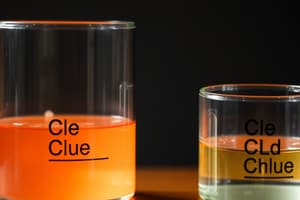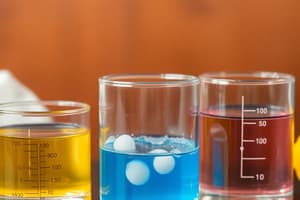Podcast
Questions and Answers
What is the specific name for the piece of equipment used to add acid to an alkali with great accuracy?
What is the specific name for the piece of equipment used to add acid to an alkali with great accuracy?
- Erlenmeyer flask
- Beaker
- Burette (correct)
- Test tube
Tooth decay is caused by alkalis produced by bacteria in the mouth.
Tooth decay is caused by alkalis produced by bacteria in the mouth.
False (B)
What products are formed when hydrochloric acid and sodium hydroxide react together?
What products are formed when hydrochloric acid and sodium hydroxide react together?
Sodium chloride and water
Medicines that are alkalis and neutralise stomach acid are called ______.
Medicines that are alkalis and neutralise stomach acid are called ______.
Match the pH level with the corresponding acidity or alkalinity.
Match the pH level with the corresponding acidity or alkalinity.
What color does a universal indicator typically display when a solution is neutral?
What color does a universal indicator typically display when a solution is neutral?
If too much alkali is added to an acid, the solution will become acidic.
If too much alkali is added to an acid, the solution will become acidic.
Why is it important to add acid slowly when trying to neutralise an alkali?
Why is it important to add acid slowly when trying to neutralise an alkali?
The process in which acids and alkalis cancel each other out to form a neutral substance is called ______.
The process in which acids and alkalis cancel each other out to form a neutral substance is called ______.
Match each term with its correct definition or description.
Match each term with its correct definition or description.
Which of the following is an example of neutralisation in everyday life?
Which of the following is an example of neutralisation in everyday life?
The digestion process in the stomach requires a neutral environment to work correctly.
The digestion process in the stomach requires a neutral environment to work correctly.
What substance do farmers spread on soil to neutralise excess acidity?
What substance do farmers spread on soil to neutralise excess acidity?
Acid rain can damage trees and alter the pH of lakes, making it necessary to add ______ to neutralise the water.
Acid rain can damage trees and alter the pH of lakes, making it necessary to add ______ to neutralise the water.
Match each substance with its pH characteristic.
Match each substance with its pH characteristic.
What does the word 'neutral' mean in the context of pH?
What does the word 'neutral' mean in the context of pH?
Neutralisation is a physical change, not a chemical change.
Neutralisation is a physical change, not a chemical change.
What process do bacteria carry out in your mouth that leads to tooth decay?
What process do bacteria carry out in your mouth that leads to tooth decay?
If the pH in a flask is 13, the solution is highly ______.
If the pH in a flask is 13, the solution is highly ______.
Match the effect with the everyday substance that helps prevent it:
Match the effect with the everyday substance that helps prevent it:
Flashcards
What is neutralisation?
What is neutralisation?
When acids and alkalis are mixed, they react to form a neutral solution.
What is a burette?
What is a burette?
A special piece of equipment used to accurately neutralise an alkali.
What is universal indicator?
What is universal indicator?
A chemical indicator that changes color depending on the pH of the solution.
What is the pH of a neutral solution?
What is the pH of a neutral solution?
Signup and view all the flashcards
Reactants in neutralisation example?
Reactants in neutralisation example?
Signup and view all the flashcards
Products of neutralisation?
Products of neutralisation?
Signup and view all the flashcards
Why stomach produces acid?
Why stomach produces acid?
Signup and view all the flashcards
What are antacids?
What are antacids?
Signup and view all the flashcards
What causes tooth decay?
What causes tooth decay?
Signup and view all the flashcards
Why toothpaste has alkali?
Why toothpaste has alkali?
Signup and view all the flashcards
Neutralising acidic soil?
Neutralising acidic soil?
Signup and view all the flashcards
Why neutralise lakes?
Why neutralise lakes?
Signup and view all the flashcards
Study Notes
- In this topic, you will learn how to make a neutral solution and why neutralisation is important.
Mixing Acids and Alkalis
- Acids and alkalis cancel each other out when mixed, reacting to form a neutral solution; this process is called neutralisation.
- Neutrality is a chemical property of a substance.
- Adding too much acid to an alkali makes the liquid acidic.
- Adding too little acid to an alkali leaves the liquid alkaline.
- Gradual addition of acid, drop by drop, helps judge when the solution becomes neutral.
Making a Neutral Solution
- A burette is a special piece of equipment used to accurately neutralise an alkali.
- A universal indicator is added to the alkali in the flask.
Burette Diagrams
- In the initial diagram, the pH in the flask is ~13.
- As acid is added, the pH decreases.
- The flask is shaken after each acid addition.
- After adding 25 cm³ of acid, the pH is 7, indicating a neutral solution.
- The acid reacts with the alkali, neutralising it.
- With a slight excess of acid, the pH drops to ~6, making the liquid weakly acidic.
- This indicates a chemical reaction where new substances form.
- Hydrochloric acid and sodium hydroxide react to produce sodium chloride and water.
Activity 8.2.1: Rainbow Neutralisation
- An activity to demonstrate the different colors shown by universal indicator solution.
- Wear safety glasses.
- A test tube is fixed into a clamp stand.
- A crystal of washing soda is placed at the bottom of the test tube.
- Add water until the tube is two-thirds full.
- Add a few drops of a universal indicator.
- Carefully pour some acid on the top of the test tube, without shaking.
- The tube is left to stand for several days.
Rainbow Neutralisation Results
- At the top, the acid turns the indicator red, showing a strongly acidic environment.
- As the acid particles move down, they mix with water, turning the indicator yellow (weakly acidic).
- In the middle, the acid and washing soda solution react, and the indicator turns yellow (neutral solution).
- At the bottom, the washing soda dissolves, turning the indicator purple/dark blue (strong alkali).
- As washing soda particles move up, they mix with more water, turning the indicator a lighter blue (weakly alkaline).
Neutralisation in Everyday Life: Indigestion
- The stomach produces hydrochloric acid, which aids in digesting food.
- Too much acid leads to indigestion, causing discomfort.
- Medicines, known as antacids, are alkalis that neutralize the excess acid.
Neutralisation in Everyday Life: Toothpaste
- Bacteria in the mouth consume food particles left on teeth.
- This produces acid that damages teeth and causes decay.
- Toothpaste contains alkali to neutralize this acid.
Neutralisation in Everyday Life: Neutralising Lakes
- Harmful chemicals in the air can cause acidic rain.
- The acidic rain damages trees and alters the pH of lakes, rivers, and ponds.
- Acidic conditions are harmful to plants and animals in lakes.
- Some countries add alkalis to lakes to neutralize the acid.
Neutralisation in Everyday Life: Growing Crops
- Soil in some areas can be too acidic for plants to grow well.
- Farmers spread lime on the soil to neutralize the acid and improve plant growth.
Think Like a Scientist: Testing the pH of the Soil
- In this task, you will test a soil sample to find its pH.
- Materials needed: 2 test tubes, a beaker of water, a filter funnel, filter paper, universal indicator, and a soil sample.
- Take a soil sample, add water, and shake.
- Filter the mixture and add a few drops of universal indicator to the filtrate.
- Record your results.
Summary checklist
- Describe neutralisation as a change to a pH of 7.
- Explain how to make a neutral solution.
- Explain why neutralisation is important.
Studying That Suits You
Use AI to generate personalized quizzes and flashcards to suit your learning preferences.



